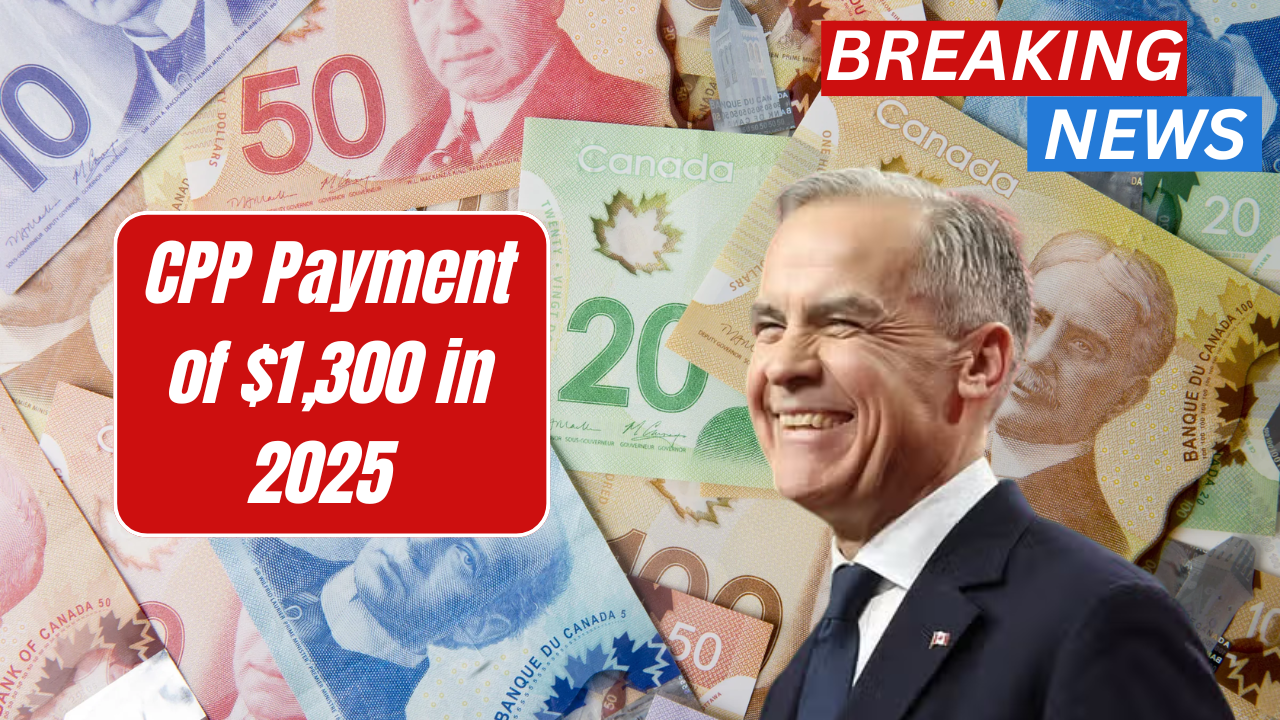1. Introduction
In June 2025, some Canadians will receive CPP payments of up to $1,300—an amount that reflects either enhanced benefits, retroactive entitlements, or qualifying criteria adjustments. This article walks you through who qualifies, how to claim it, and when to expect it in your account.
2. What Is the CPP?
The Canada Pension Plan (CPP) is a government-administered retirement pension scheme available to most working Canadians. It’s a contributory, earnings-based plan, meaning:
- You contribute through payroll deductions
- The more you earn and contribute, the more you receive in retirement
CPP offers several benefits:
- Retirement pension
- Disability benefits
- Survivor’s pension
- Children’s benefits
- Death benefit

3. What’s Behind the $1,300 CPP Payment in June 2025?
While the average CPP retirement benefit is significantly less than $1,300, there are specific cases where individuals can receive this amount:
- Maximum monthly pension + retroactive payments
- CPP disability + children’s benefit combined
- Survivor’s pension + own pension
- Retroactive adjustments due to late application
- Lump-sum payment corrections
Thus, this $1,300 isn’t standard—it’s conditional and situational.
4. Who Is Eligible for This Payment?
To be eligible for any CPP payment (including large sums like $1,300), you must:
- Have contributed to the CPP while working
- Be at least 60 years old for retirement pension
- Be under 65 and significantly disabled for CPP Disability
- Be a surviving spouse or child of a deceased contributor for survivor’s and children’s benefits
Other requirements:
- Contributions must meet the minimum threshold
- Your earnings and work history determine benefit size
- A valid Social Insurance Number (SIN) is required
5. Payment Structure: Regular CPP vs Enhanced CPP
| Feature | Base CPP | Enhanced CPP (Post-2019) |
|---|---|---|
| Contribution % | 4.95% each (employer & employee) | Higher due to enhancements |
| Max Monthly Payment (2025) | ~$1,364 | Could exceed this in specific cases |
| Eligibility Age | 60-70 | Same |
| Indexed to Inflation? | Yes | Yes |
6. Breakdown: Monthly Maximums and Average Amounts
| Type of CPP Benefit | Average Monthly (2025 est.) | Maximum Monthly (2025 est.) |
|---|---|---|
| Retirement Pension | $758 | $1,364 |
| CPP Disability | $1,150 | $1,538 |
| Survivor’s Pension (under 65) | $638 | $791 |
| Survivor + Retirement Combined | Varies | Could reach ~$1,300 |
| Child of Disabled/Deceased | ~$290 | ~$290 |
As you can see, combined benefits or retroactive payouts are how one might reach or exceed $1,300.

7. How to Apply for CPP
You can apply:
- Online through My Service Canada Account (MSCA)
- By mail using a paper application form
- In person at Service Canada centres
Tips:
- Apply 6 months before your desired payment start date
- Be sure your banking and contact information is up-to-date
8. Required Documents and Application Channels
| Document | Required For |
|---|---|
| Birth Certificate | All applicants |
| SIN (Social Insurance Number) | All applicants |
| Proof of disability | CPP-D only |
| Death certificate (spouse) | Survivor’s benefits |
| Banking details | Direct deposit |
9. CPP Payment Dates – June 2025 and Beyond
The CPP payment schedule is set annually. For June 2025, payments are likely to fall on:
📅 Wednesday, June 26, 2025
Payments are made by direct deposit, or by cheque if you haven’t enrolled electronically (which may take longer).
10. Special Scenarios That Could Trigger a $1,300 Payment
- Applied late and qualified for 11 months of retroactive pension
- Combination of:
- Retirement pension
- Survivor’s pension
- Disability benefit
- Recalculation due to higher income contributions from past work
- CPP Disability and Child Benefit issued jointly
11. Taxes on CPP Income
- CPP payments are taxable income
- You can request that taxes be withheld from your monthly payment
- Include your CPP in your annual income tax return
12. Receiving Payments While Working
Yes, you can receive CPP and still work, but:
- If under age 70, you will continue to contribute (unless you opt out at 65)
- Continued contributions may qualify you for Post-Retirement Benefit (PRB), increasing your monthly CPP amount
13. Early vs Late CPP Payments
| Start Age | Monthly Payment (2025 est.) | Notes |
|---|---|---|
| 60 | ~$970 | Reduced by 36% from full amount |
| 65 | ~$1,364 | Standard full payment |
| 70 | ~$1,930 | Increased by 42% for deferring |
Late application + retro pay could help generate a $1,300+ month.
14. How the CPP Enhancement Plan Impacts You
CPP Enhancements began in 2019:
- Higher contributions = higher eventual benefits
- Aims to replace one-third of pre-retirement income (up from 25%)
- Beneficial especially for younger and mid-career workers
15. Difference Between CPP and CPP Disability Benefits
| Feature | CPP Retirement | CPP Disability |
|---|---|---|
| Eligibility Age | 60+ | Under 65 |
| Health Requirement | None | Must prove disability |
| Monthly Amount | $758 avg | $1,150 avg |
| Child Benefit | No | Yes (~$290/month/child) |
16. How Retroactive Payments Can Add Up to $1,300
Example:
- Missed your retirement application for 5 months
- Qualified for full CPP
- Received:
- $1,300 lump sum for June
- $5,000 in retroactive payments
- Total = $6,300 in one deposit
17. Case Studies of Real Beneficiaries
Case 1: Joseph, 67
- Delayed application
- Full contributions for 40 years
- Received $1,364 + $800 back pay = $2,164 in June
Case 2: Helen, 62, widow
- Collects her own pension + survivor’s
- Receives ~$1,250 combined in June
18. CPP and Survivors: Are Spouses Eligible for $1,300?
Yes, if:
- Deceased spouse was a high-contributor
- Survivor has low or no CPP income of their own
- Combined survivor + retirement benefits can reach $1,300 cap limit defined by Service Canada
19. Provincial Supplements to CPP
Some provinces offer:
- GAINS (Ontario)
- Senior’s Benefit (Alberta)
- Seniors Supplement (BC)
These can be stacked with CPP but don’t count toward the $1,300.
20. Conclusion
While the standard CPP pension doesn’t typically reach $1,300, certain eligible Canadians can indeed receive $1,300 or more in June 2025 due to a mix of full eligibility, retroactive payments, disability, survivor benefits, and late applications.
To benefit fully:
- Check your contribution record
- Apply strategically
- Use My Service Canada Account to manage your payments
The CPP is not just a retirement tool — it’s a safety net for multiple life events. If you’re in line for $1,300, it’s worth understanding how and why.
21. FAQs
1. Can everyone get $1,300 in CPP?
No. Only certain individuals who meet specific criteria (e.g., maximum contributions, multiple benefit types) receive $1,300.
2. Will I be taxed on my $1,300 CPP payment?
Yes, all CPP income is taxable. You can request voluntary tax deductions or pay taxes when filing.
3. How do I know if I’m eligible for a retroactive payment?
If you apply late or your file was reassessed, you may qualify for retroactive payments up to 11 months.
4. Can I get CPP payments and still work?
Yes, and you may receive additional Post-Retirement Benefits if you’re under 70.
5. How long does it take to get approved for CPP?
Typically 1 to 4 months, depending on how complete your application is and whether supporting documents are needed.


